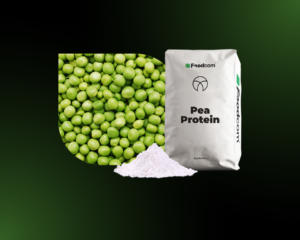- Pea protein is seeing rapid market growth, driven by the increasing popularity of plant-based diets and sustainable foods, despite rising transportation costs from China.
- Fava protein, valued for its complete amino acid profile and neutral taste, is becoming a popular alternative to animal protein, particularly in functional food production.
- India’s adjustments to rice export prices and taxes aim to manage surplus stockpiles and enhance international competitiveness.
Welcome to our plant-based newsletter!
This week, we explore the growing market for plant-based proteins, focusing on the expansion and challenges of pea protein, fava protein, and brewer’s yeast. As sustainable and functional food ingredients gain popularity, these products are becoming more prominent. Additionally, we cover key global agricultural updates, including India’s adjustments to rice export policies, skepticism about USDA’s corn yield forecasts, and the shifting weather patterns impacting Argentina’s agriculture.
Let’s take a look at what else is happening on the market!
Products of the week
Pea Protein
The pea protein market continues its rapid expansion. Key factors driving this growth are the increasing popularity of plant-based diets, greater consumer awareness of sustainable foods, and intensifying efforts to reduce the food industry’s carbon footprint. However, pea protein prices are on the rise, mainly due to rising transportation costs from China, a major supplier to the global market. Meanwhile, although prices in the European Union remain stable, the European product is significantly more expensive compared to imports from China, which affects consumers’ purchasing decisions and producers’ pricing strategies.
Fava Protein
Fava protein is gaining popularity as one of the newer alternatives to animal protein. Due to its high protein content, complete amino acid profile, abundance of fiber and richness in vitamins and minerals, fava protein is becoming a key ingredient in the production of protein nutrition and feed for some animals, such as pigs. In addition, its unique properties – neutral taste and odor – make it a valuable element in the production of functional foods. Although the price of bean protein is higher than that of pea protein, its lack of characteristic taste and odor allows producers to save on flavor additives and neutralizers, which can reduce overall production costs and facilitate the formulation of products with desirable sensory properties. Investments in the development of extraction and processing technologies by producers in Europe and North America are making bean protein increasingly available and popular in global markets.
Brewer’s Yeast
The market for brewer’s yeast is experiencing rapid growth, driven by increasing demand for natural and functional ingredients in dietary supplements and animal feed. Dietary supplements, using beer yeast for its richness in B vitamins, proteins and minerals, represent the largest market segment. At the same time, demand for brewer’s yeast as a natural feed additive is increasing, making a significant contribution to animal health and performance, being a key element in the poultry and swine sectors. Europe dominates the global market, while North America and the Asia-Pacific region are experiencing significant growth, supported by the growing craft beer industry and changing consumer dietary preferences.
NEWS
India to adjust rice export prices and taxes amid surplus
which have reached a record 48.51 million metric tons. The government will lower the minimum export price of basmati rice from $950 to between $800 and $850 per metric ton to enhance international competitiveness, particularly against Pakistan. Additionally, it plans to replace the current 20% export tax on parboiled rice with a fixed duty, aiming to prevent under-invoicing and boost overseas shipments. These adjustments come in response to the necessity of reducing domestic rice surplus to prevent spoilage and retain market share.
USDA’s high corn yield forecasts meet market skepticism
U.S. corn yield predictions by the USDA have consistently overestimated actual yields for the past five years, raising concerns among grain industry experts. For 2024, the USDA’s trend yield is set at 181 bushels per acre, which is 3.7 bpa higher than last year’s record. Despite these optimistic projections, recent market actions reveal traders building record-short positions, indicating skepticism and potentially bracing for yields to surpass even the lofty expectations of 181 bpa. The USDA will update its yield forecasts on August 12, factoring in the latest crop conditions, which as of mid-July, are rated 68% good-to-excellent—slightly above the decade’s average.
Weather shifts impact Argentina’s agriculture
Argentina’s agricultural regions are experiencing a shift in weather patterns, with cold temperatures set to ease in the coming days despite ongoing possibilities of snowfall, according to the Buenos Aires Grains Exchange. The exchange forecasts that tropical winds will lead to above-normal temperatures in the north, normal in the center, and slightly below-normal in the south of the agricultural areas. A cold front known as the Pampero is expected to bring minimal precipitation, impacting the ongoing harvest of the 2023/24 corn crop and the planting of the 2024/25 season.
![The next big thing: Pea and Fava Proteins revolutionize the market! [61st PLANT-BASED Newsletter] The next big thing: Pea and Fava Proteins revolutionize the market! [61st PLANT-BASED Newsletter]](https://foodcom.pl/wp-content/uploads/2023/08/Foodcom_Plant-Based_Newsletter-1520x760.jpg)





